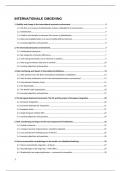Resume
Samenvatting internationale omgeving
- Établissement
- Universiteit Antwerpen (UA)
Volledige samenvatting van het vak Internationale Omgeving gegeven door de proffen Sascha Albers en Johan van Gompel. Het eerste deel is in het Engels en het tweede deel in het Nederlands.
[Montrer plus]



